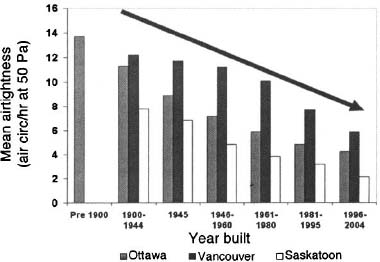An Integration Challenge: Information and Communication Technologies to Address Indoor Air Quality in Commercial Buildings
National Research Council Canada, Institute for Microstructural Sciences Ottawa, Ontario, Canada, K1A 0R6
1. Introduction
Much attention has been drawn to health problems related to airtight building environments with poor indoor air quality or limited ventilation capabilities.1 This problem is encountered not only in commercial buildings, but also in homes where modern construction materials have exacerbated the problem. In the last century, the air tightness of a typical Canadian building has improved by 48% between 1900 and 1960 and a further 25% between 1960 and 2004, driven in part, by the energy crisis of the 1970’s. Fig. 1 illustrates this trend for three Canadian cities.2
Indoor air pollutants include tobacco smoke, dust mites, animal dander, molds, combustion gases, volatile organic compounds (VOC) and heavy metal dust. The building and insulating materials that allow us greater comfort in our homes also outgas contaminants that are deleterious to our health. Some of the sources of contamination are shown in Table 1.

Figure 1. Mean air tightness in buildings in three Canadian cities measured in air circulation per hour at a pressure of 50 Pascals.2
Table 1. Sources of contamination in indoor environments.
As a result, lung diseases and ...
Get Future Trends in Microelectronics: From Nanophotonics to Sensors to Energy now with the O’Reilly learning platform.
O’Reilly members experience books, live events, courses curated by job role, and more from O’Reilly and nearly 200 top publishers.

